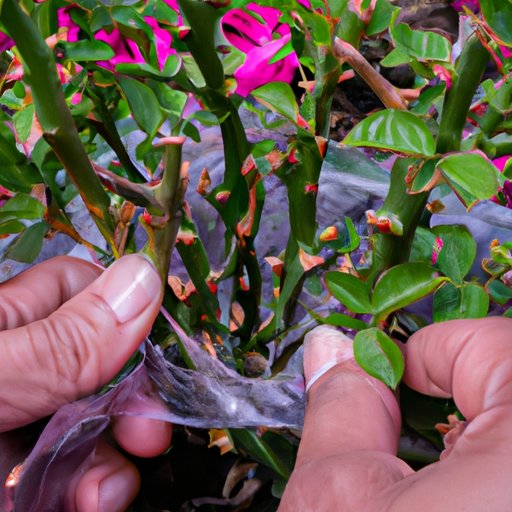
Introduction
Growing roses is a beloved hobby for many gardeners. While it’s possible to purchase established rose plants, propagating roses allows you to produce new plants from your existing favorites. Propagation can, however, be a challenge for inexperienced gardeners. This step-by-step guide aims to simplify the process and help readers successfully propagate roses.
Step-by-Step Guide
Preparation
Before you start propagating your roses, gather the necessary materials. You’ll need rooting hormone, sharp pruning shears, a small container, and good-quality potting mix. Additionally, choose a healthy rose plant that produces woody stems.
Cutting and Rooting
1. Select a stem for cutting. Look for stems that are healthy and disease-free and have at least three sets of leaves.
2. Cut the stem with sharp pruning shears at a right angle to ensure no damage is done. The cutting should also be made at a 45-degree angle to encourage rooting.
3. Remove any leaves or flowers from the cutting, leaving just a few sets of leaves near the top of the cutting.
4. Dip the bottom end of the cutting in rooting hormone powder to encourage root growth.
5. Plant the cutting in a small container filled with moist soil as soon as possible.
6. Cover the container with a plastic bag or clear plastic wrap to create a greenhouse effect. This will keep the cutting humid and promote root growth.
Care and Maintenance
1. Keep the soil moist, but not saturated with water. Water the container when the top inch of soil feels dry.
2. Keep the container in a warm and bright location. Provide indirect light with some shade during the hottest part of the day, but don’t place the container in direct sunlight.
3. Wait patiently for new growth and signs of root development. This can take weeks to months. Check occasionally by lightly tugging on the cutting to see if it has rooted.
4. When the cutting has grown roots and new growth has appeared on the stem, transplant the cutting into a larger pot or garden bed with well-draining soil.
Tips & Tricks for Success
Timing
Propagate during the spring or early summer when temperatures are moderate, and the plant is actively growing. Avoid propagating during extreme weather conditions like intense heat or cold snaps.
Soil
Use a well-draining soil mix for the cutting. A mix of perlite, vermiculite, or sand can help improve drainage.
Protection and Hydration
Keep the cutting away from direct sunlight, which can scorch or dry out the cutting. Mist the plants regularly to keep them hydrated, especially in dry conditions. This can also mitigate the effects of harsh sunlight.
Expert Insights
We interviewed a local gardener with decades of experience growing roses. She recommends taking the cutting from a rosebud that hasn’t quite bloomed yet. “The stem has enough energy to produce roots and will have successful propagation rates.” She suggests placing the cutting in a shaded area and misting it regularly to keep it hydrated.
Troubleshooting Tips
Rot
If the soil becomes too saturated, the cutting may rot. Use a well-draining soil mix and ensure the soil doesn’t get waterlogged. You should also avoid overwatering the cutting and monitor the substrate’s moisture level consistently.
Pest Infestations
If the cutting is infested with pests, like spider mites or aphids, apply an insecticidal soap or neem oil to combat the issue. Quarantine the pot until the problem is resolved, and keep it away from other potentially infested plants.
Non-rooting Cuttings
If the cutting fails to root, recut the stem at a 45-degree angle and renew the base of the stem to a half-inch nub. Wait longer, and the cutting may sprout roots.
Use of Social Media
Share your successful and not-so-successful propagation results on social media platforms. Create a quick photo series or video clip to show off the process. Use relevant hashtags and tags to attract other rose gardeners and plant enthusiasts.
Conclusion
Propagating roses can be a fun and rewarding way to grow more of your favorite rose plants. With the right tools and techniques, anyone can successfully propagate roses. Remember to be patient and monitor your cutting’s growth.





